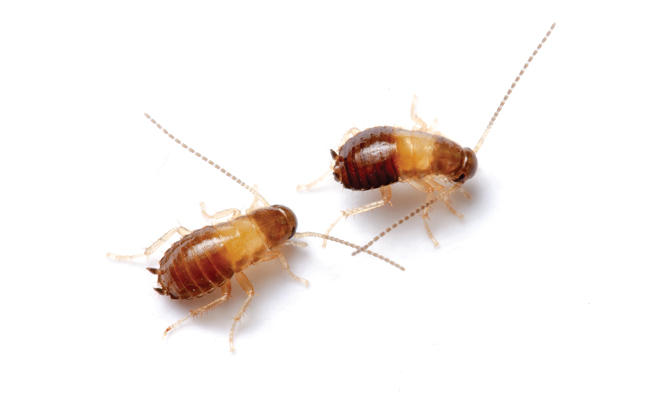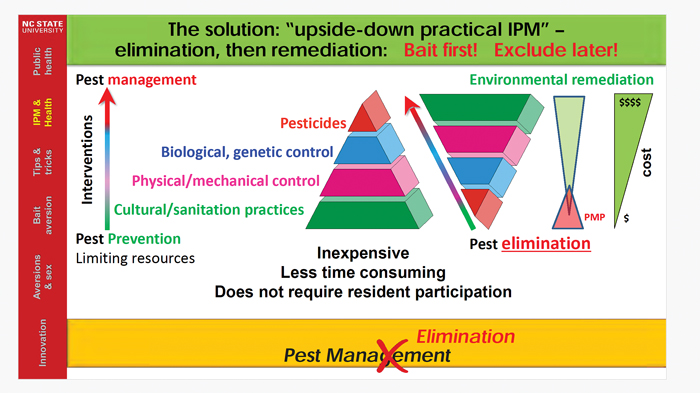
Cockroaches are seemingly evolving in their bait aversion traits, a situation many pest management professionals (PMPs) have experienced.
Determining why this happens is critical because cockroaches, particularly the German cockroach (Blattella germanica), pose a public health threat. Studies have shown that cockroach allergens from their feces, dead bodies and molted skins can contribute to asthma, especially in children living in low-income, multi-family housing. In fact, a 1997 study estimated approximately 37 percent of “inner-city” children with asthma are sensitized to cockroach allergens.
Because the same bacteria in the cockroach gut can be found in its feces, it also can transmit pathogens from whatever it eats to whatever it leaves behind in its droppings. This is particularly concerning when a cockroach travels from a bathroom to a kitchen, for example — potentially contaminating surfaces along the way.
A 2011 study I was part of looked at antibiotics used in veterinary medicine and found multidrug antibiotic resistance and multidrug resistance mutations genes were identical in Enterococcus bacteria found in both pig feces and cockroach feces. Antibiotic-resistant bacteria also were found in a few cockroach populations in urban homes in Raleigh, N.C.
As cockroaches become exposed to specific bait formulations, certain populations can develop resistance, leading to reduced efficacy. With cockroaches’ rapid reproduction rate, these resistance genes are passed along to subsequent generations, making each new cockroach a little more resistant than before. This adaptive behavior means the professional pest management industry needs to stay a step ahead of cockroaches with product development and best management practices.

A different look at IPM
As PMPs, we have long observed the “pyramid” of integrated pest management (IPM) principles — that is, start with the cultural and sanitation measures such as vacuuming, decluttering, installing door sweeps, and more; then physical controls like traps and monitors; then biological control like insect growth regulators (IGRs); and finally using pesticides in a judicious and targeted manner as needed.
When it comes to heavy cockroach infestations that pose an immediate public health threat — particularly in multi-family complexes where populations can infiltrate far and wide — we have found through recent studies that it’s OK to turn that pyramid upside down. In other words, bait first, exclude later. This approach aims to knock down the population quickly, with less material and labor used overall. Best of all, it doesn’t even require resident participation.
We first tried this “upside-down practical IPM” approach in a 2003 apartment complex study. We used vacuums and sticky traps to quantify cockroach allergens and the number of cockroaches in each unit’s kitchen, living room and bedroom. In infested units, we either baited (intervention units) or did nothing (control units). No other pest control methods were used.
Over six months, we learned there was no change in the infested, untreated control units. There was, however, a more than 98 percent reduction in the baited intervention units — with no reinfestation. In a similar study in 2017 in New Orleans, La., we found that:
- Children in intervention homes had fewer asthma symptoms and fewer emergency room visits.
- Children in intervention homes had better pulmonary function than those living in control homes.
Nearly all modern cockroach control methods have their place. But cockroach baits have the advantage of targeting all life stages, bringing population growth to a halt.
An art and a science

Visually monitoring and using monitoring traps are key to making “upside-down practical IPM” work. So is remembering the label is the law, even when labels on different baits can practically contradict one another.
Follow the label and your monitoring results to see where to place the bait. Best practices include:
- Bait close to aggregations.
- Bait near travel routes such as structural edges, table legs and electrical conduits.
- Keep in mind that bait is not caulk. Use small dabs, not streaks.
- Try not to overapply, but don’t underapply, either.
- Realize baiting takes time and cost initially, but is more efficient in the long run. After the baiting knockdown, you can focus on treating the root causes and implement a maintenance program.
- Be explicit in your contracts about baiting and monitoring, and what your customers
can expect. - Rotate bait active ingredients to avoid creating bait-averse populations.
- Implement maintenance monitoring so you’re on top of any reinfestations.
Very educative forum about pests within our environment which we can practice both chemical and IPM standards .